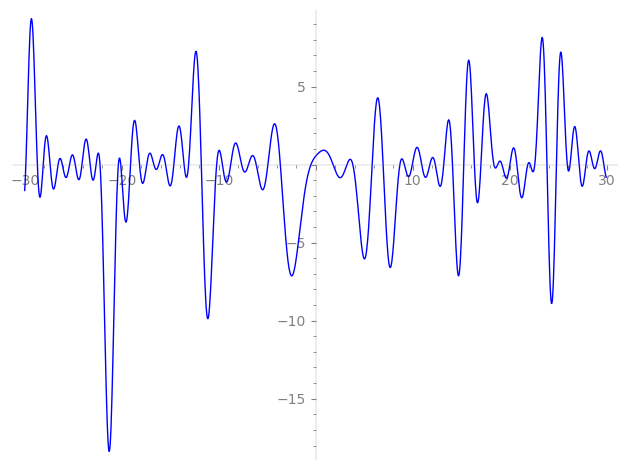| L(s) = 1 | + (−0.760 + 2.33i)2-s + (−3.27 − 2.38i)4-s + (−0.305 − 0.941i)5-s + (−3.49 − 2.54i)7-s + (4.08 − 2.96i)8-s + 2.43·10-s + (2.79 + 1.79i)11-s + (1.11 − 3.44i)13-s + (8.60 − 6.25i)14-s + (1.33 + 4.11i)16-s + (−0.816 − 2.51i)17-s + (3.09 − 2.24i)19-s + (−1.23 + 3.81i)20-s + (−6.31 + 5.16i)22-s − 3.45·23-s + ⋯ |
| L(s) = 1 | + (−0.537 + 1.65i)2-s + (−1.63 − 1.19i)4-s + (−0.136 − 0.420i)5-s + (−1.32 − 0.960i)7-s + (1.44 − 1.04i)8-s + 0.770·10-s + (0.841 + 0.540i)11-s + (0.310 − 0.954i)13-s + (2.29 − 1.67i)14-s + (0.333 + 1.02i)16-s + (−0.197 − 0.609i)17-s + (0.710 − 0.516i)19-s + (−0.277 + 0.853i)20-s + (−1.34 + 1.10i)22-s − 0.719·23-s + ⋯ |
Λ(s)=(=(297s/2ΓC(s)L(s)(0.977+0.209i)Λ(2−s)
Λ(s)=(=(297s/2ΓC(s+1/2)L(s)(0.977+0.209i)Λ(1−s)
| Degree: |
2 |
| Conductor: |
297
= 33⋅11
|
| Sign: |
0.977+0.209i
|
| Analytic conductor: |
2.37155 |
| Root analytic conductor: |
1.53998 |
| Motivic weight: |
1 |
| Rational: |
no |
| Arithmetic: |
yes |
| Character: |
χ297(163,⋅)
|
| Primitive: |
yes
|
| Self-dual: |
no
|
| Analytic rank: |
0
|
| Selberg data: |
(2, 297, ( :1/2), 0.977+0.209i)
|
Particular Values
| L(1) |
≈ |
0.550573−0.0582124i |
| L(21) |
≈ |
0.550573−0.0582124i |
| L(23) |
|
not available |
| L(1) |
|
not available |
L(s)=p∏Fp(p−s)−1 | p | Fp(T) |
|---|
| bad | 3 | 1 |
| 11 | 1+(−2.79−1.79i)T |
| good | 2 | 1+(0.760−2.33i)T+(−1.61−1.17i)T2 |
| 5 | 1+(0.305+0.941i)T+(−4.04+2.93i)T2 |
| 7 | 1+(3.49+2.54i)T+(2.16+6.65i)T2 |
| 13 | 1+(−1.11+3.44i)T+(−10.5−7.64i)T2 |
| 17 | 1+(0.816+2.51i)T+(−13.7+9.99i)T2 |
| 19 | 1+(−3.09+2.24i)T+(5.87−18.0i)T2 |
| 23 | 1+3.45T+23T2 |
| 29 | 1+(8.43+6.12i)T+(8.96+27.5i)T2 |
| 31 | 1+(0.521−1.60i)T+(−25.0−18.2i)T2 |
| 37 | 1+(2.61+1.90i)T+(11.4+35.1i)T2 |
| 41 | 1+(9.63−6.99i)T+(12.6−38.9i)T2 |
| 43 | 1+2.12T+43T2 |
| 47 | 1+(−3.47+2.52i)T+(14.5−44.6i)T2 |
| 53 | 1+(−2.93+9.01i)T+(−42.8−31.1i)T2 |
| 59 | 1+(−5.23−3.80i)T+(18.2+56.1i)T2 |
| 61 | 1+(1.48+4.57i)T+(−49.3+35.8i)T2 |
| 67 | 1−0.854T+67T2 |
| 71 | 1+(−1.16−3.59i)T+(−57.4+41.7i)T2 |
| 73 | 1+(9.22+6.70i)T+(22.5+69.4i)T2 |
| 79 | 1+(−1.89+5.84i)T+(−63.9−46.4i)T2 |
| 83 | 1+(1.03+3.19i)T+(−67.1+48.7i)T2 |
| 89 | 1−13.2T+89T2 |
| 97 | 1+(0.114−0.353i)T+(−78.4−57.0i)T2 |
| show more | |
| show less | |
L(s)=p∏ j=1∏2(1−αj,pp−s)−1
Imaginary part of the first few zeros on the critical line
−11.79352980579389799819635931742, −10.21279980881927434431787373295, −9.620055280831698403154925274866, −8.769957324861384373500141217039, −7.63803551986965951900322125875, −6.93420208250645759408920024757, −6.13255857268088504547818583329, −4.93176813650560240501840717571, −3.64655979471249254612830349645, −0.49843646682302213205710900217,
1.79042180123302417045234622418, 3.21274937553011830155026481865, 3.82586125915300107957783556189, 5.81129469778722963632286510019, 6.94585647552529873539542260642, 8.674116902556386504263998433233, 9.136825690705868354432325332636, 9.957639111193382433775397615698, 10.92703046267470928767276170499, 11.76041003449640865477771633665

